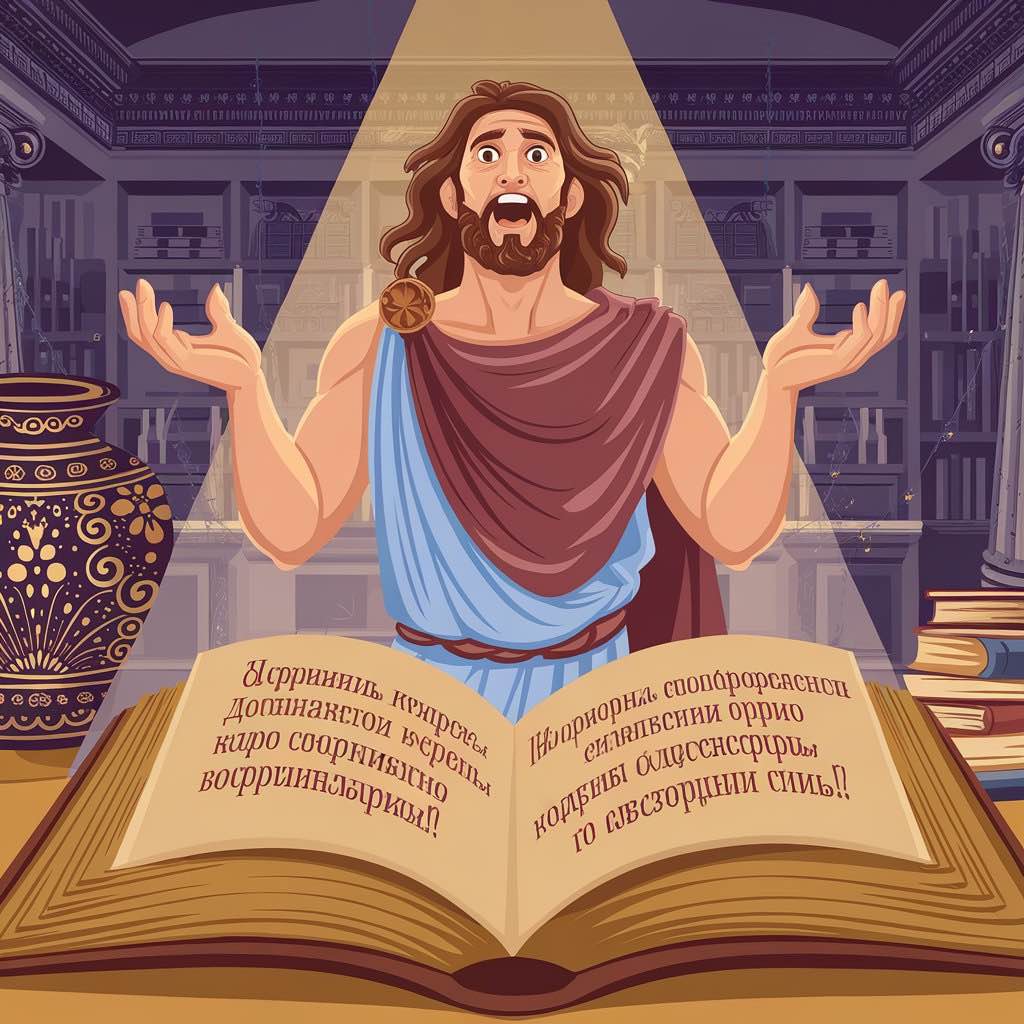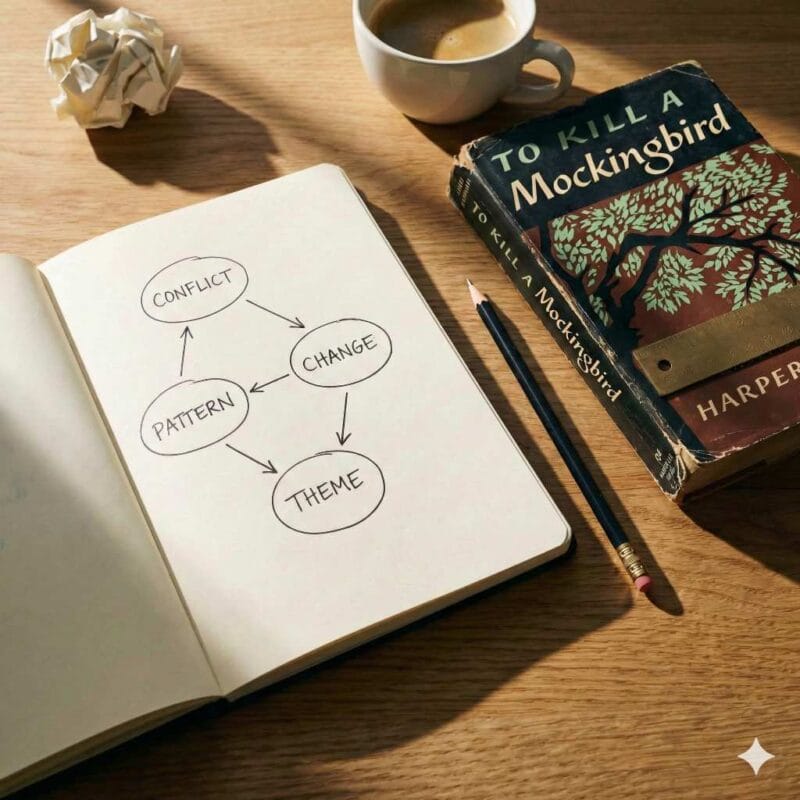The roots of ekphrasis can be traced back to ancient Greece’s education practices. Known as progymnasmata, these exercises were used to train students in writing by creating evocative descriptions of art. This method not only honed rhetorical skills but also enriched the way stories could be built from visual stimuli.
The eighteenth century saw a revival and evolution of these concepts, paving the way for modern interpretations. In this era, literature began responding more directly to visual arts, helping to expand narrative forms and the exploration of intermediality, or the interaction between different art forms.
As art history and literary pursuits continued to merge, ekphrasis became a reflection of these interactions, providing artists and writers a medium to experiment. Whether capturing the essence of a painting or reimagining a scene from sculpture, ekphrastic writing sparks a dialogue between the arts.
Examples of Ekphrasis in Literature
Exploring ekphrasis in literature reveals how authors since ancient times vividly describe art in their works. Its early use is most commonly associated with poetry, where writers like Homer and later poets like John Keats employed ekphrastic descriptions to create a bridge between the visual and literary arts.
In ekphrastic poems, such as Keats’ “Ode on a Grecian Urn” (1819), the art being described becomes central to the poem’s themes, often serving as a metaphor for broader human experiences. This tradition emphasized the emotional and interpretative power of language to convey the essence of art, enriching the reader’s understanding of both the visual piece and the literary text.
Homer’s The Iliad (1598) is another classic example of ekphrasis in the form of Achilles’ shield, where the shield’s extensive description creates a vivid image in the reader’s imagination. This detailed portrayal highlights the intricacies of the armor piece, emphasizing its significance in the narrative.
Additionally, W. H. Auden’s “The Shield of Achilles” (1952) revisits Homer’s theme, using ekphrasis to contrast ideals with reality. Auden’s work serves as an important modern take on classical literature, providing readers with insights into cultural and personal themes depicted in art.
Ekphrasis Beyond Poetry
While ekphrasis is traditionally associated with poetry, its application extends into various literary forms, enriching prose and narrative fiction as well. In novels like Donna Tartt’s The Goldfinch (2013) and Wilde’s The Picture of Dorian Gray (1890), detailed descriptions of paintings play crucial roles, adding symbolic profundity to the characters and plot.
In addition to fiction, ekphrasis is employed in essays and other nonfiction works where art is analyzed or deeply described. Writers use it to bridge the gap between visual and verbal mediums, enabling readers to experience art through language. This technique not only promotes deeper thematic exploration but also encourages imagining or engaging with the artwork on a more personal level, regardless of the literary form used.
Effects of Ekphrasis on Readers
The process of seeing artwork through words involves the detailed exploration of visual elements embedded in text. Through ekphrastic writing, authors could convey the full scope of artistic expression and transport readers into the scene, enabling them to see and feel as if they are engaging directly with the artwork.
Emotional and Sensory Engagement
The use of ekphrastic elements can mirror the timeless beauty seen in art pieces. This approach helps visualize and emotionally connect with artworks that may have never been seen, enabling a dynamic dialogue between text and image and thereby encouraging the representation of visual art within the context of literature.
Through vivid descriptions of visual arts, ekphrastic writing provides a unique way of enhancing emotional and sensory experiences. Ekphrastic literature captures the senses through meticulous descriptions by evoking the colors, textures, and emotions of the artwork.
For instance, in Robert Browning’s “My Last Duchess” (1842), the poem narrates the story behind a portrait, drawing the reader into a deeper understanding of the depicted scene. Such narrations temporarily freeze the moment in time, creating space to linger and explore its intricate details.
Deepening Reader’s Connection to Art
As ekphrastic poems translate visual experiences into words, they enrich the way readers perceive art. Consider how William Carlos Williams’ “Landscape with the Fall of Icarus” (1960) captures the dramatic moment depicted in Pieter Bruegel’s painting. This work presents the emotional subtleties of the scene for engagement.
In Percy Bysshe Shelley’s “On the Medusa of Leonardo Da Vinci in the Florentine Gallery” (1824), he opens the way for the exploration of the painting’s haunting imagery. By describing the meditative horror, Shelley creates a connection between art and text.
Lastly, Robert Browning’s work often employed ekphrasis, like his dramatic monologues inspired by paintings. Such uses highlight the potential of poetry to bring static images into dynamic human narratives, transforming how art is interpreted and felt through words.
Ekphrasis and Personal Interpretation
Ekphrasis leads to differing visualizations and feelings, as each reader envisions and experiences the described artwork in their own way. While one might perceive a painting described in a text with vivid hues and grandeur, another may focus on the subtler emotional undertones. This divergence stems from individual emotional responses and past experiences with art and literature.
Word and image interplay significantly influences these interpretations. The writer’s choice of language, tone, and detail can direct a reader’s focus, sparking unique feelings and visualizations. As highlighted in literary analysis, such personal engagement enriches the reading experience, which stimulates diverse reactions and interpretations without a singular, fixed meaning.
Ekphrasis Beyond Paintings
Ekphrasis extends beyond just paintings, engaging with a variety of visual arts such as sculptures and contemporary works. This section explores how ekphrastic prose and poetry capture the essence of different art forms, offering more than just description.
Describing Sculptures and Architecture
When poets and writers engage with sculptures, they often highlight the three-dimensional nature of the work. Sculptures hold an essence that challenges writers to capture not just what is seen, but also what is felt. Writers might focus on the unique textures and lines, enabling a “seeing” of the object through the lens of words.
Architecture presents a different challenge in ekphrastic expression. Writers must navigate the interaction of space and form, illustrating large structures and their impacts on surroundings. Through vivid imagery, texts attempt to describe how light plays off a building or how spaces invite human interaction. Writers might reference famous structures, like the awe-inspiring cathedrals of Europe, as examples of ekphrastic work capturing not just the building but also the atmosphere and mood they evoke.
Ekphrasis in Modern Art
Modern art’s abstract nature presents unique opportunities for ekphrasis. Artists like Vincent van Gogh and Edward Hopper provide rich material for ekphrastic exploration. “The Starry Night” and Hopper’s urban scenes provide prose and poetry with the means to dive into color, form, and emotional undertones without literal interpretation.
Modern installations and contemporary art raise questions rather than provide answers. Writers use ekphrasis to speculate on the artist’s intent or to create narratives around visual cues. Works seen in venues such as the Musée des Beaux Arts offer inspiration for ekphrastic texts that traverse beyond traditional art forms, engaging with art that defies simple categorization. This creates a dialogue between the viewer and the artwork through written expression.
Further Reading
From the front lines: The magic of ekphrasis by Yi Shun Lai, The Writer
Ten of the best: examples of ekphrasis by John Mullan, The Guardian
Explore Ekphrastic Poems: A Reading List by Aunye Boone, National Endowment for the Arts
“What is Ekphrasis?”: A Literary Guide for English Students and Teachers by OSU School of Writing, Literature and Film, YouTube




